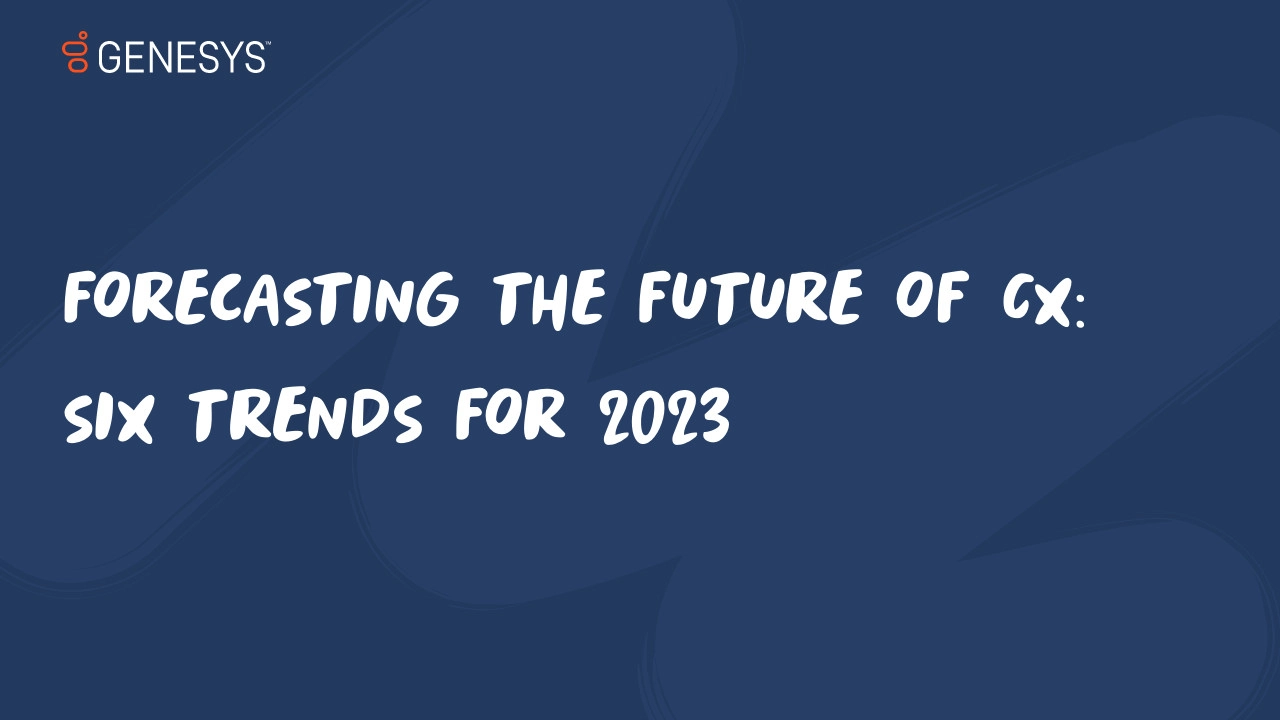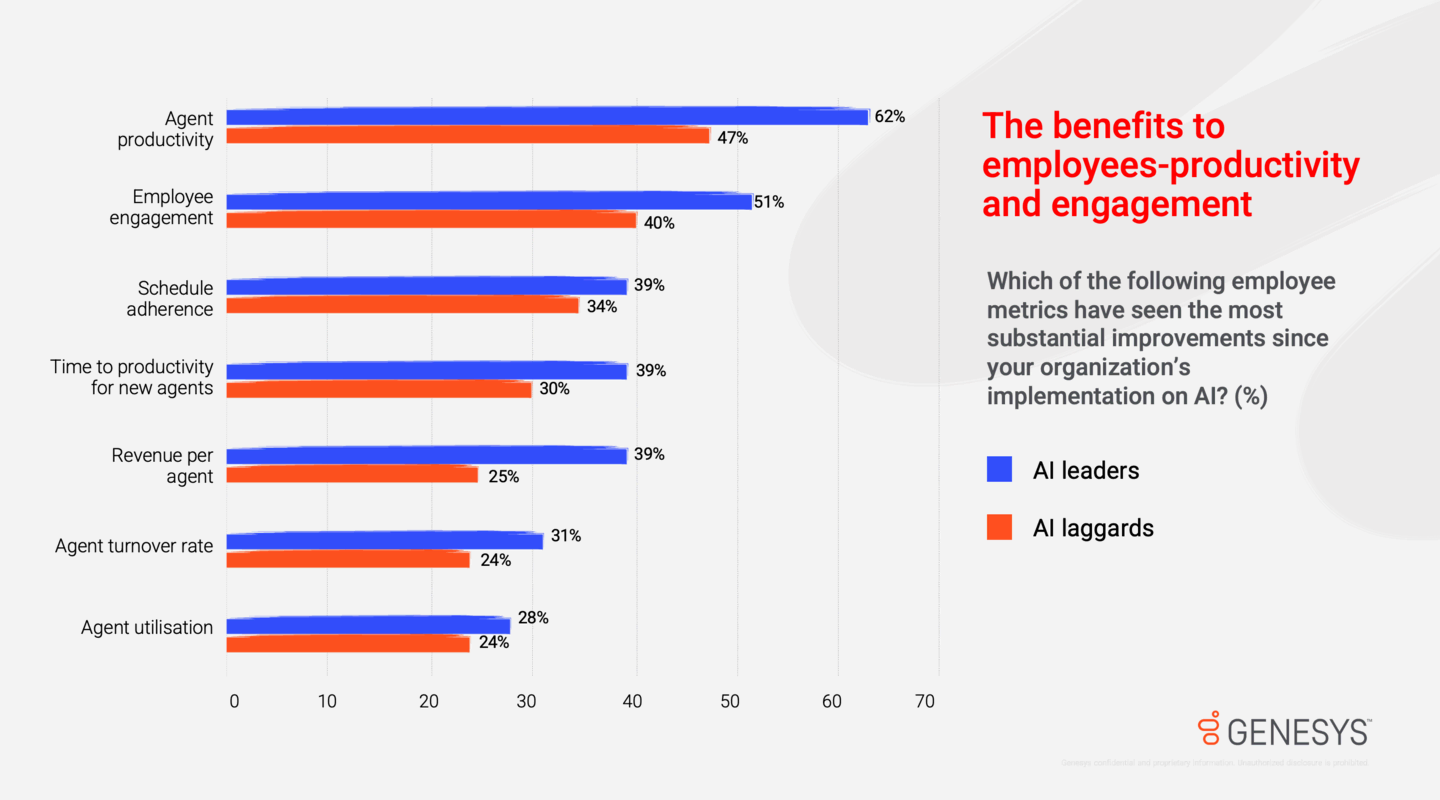Your Genesys Blog Subscription has been confirmed!
Please add genesys@email.genesys.com to your safe sender list to ensure you receive the weekly blog notifications.
Subscribe to our free newsletter and get blog updates in your inbox
Don't Show This Again.

Delivering empathetic, engaging employee experiences has become a top priority for a growing number of organizations. Those that use artificial intelligence (AI) in the workplace to support their customer-facing employees are seeing benefits that extend from increased employee satisfaction to improved financial performance.
Organizations considered AI leaders in the Economist Impact report, “AI comes of age,” for example, benefit from using the technology to support their customer-facing employees. Two-thirds of business executives surveyed said employee productivity substantially improved. Half saw notable gains in employee engagement and nearly 40% achieved increases in revenue per agent.
The more widely an organization leverages AI in ways that support the employee experience, the better the results will be. But AI-led employee engagement initiatives don’t need to be grandiose.
To see improvements when using artificial intelligence in the workplace, organizations should start with a defined set of use cases that drive business results and progress after each initiative becomes a successful, embedded process. And AI can make a significant impact through employee engagement, real-time agent assist and overall performance improvements.
Let’s take a look at four preliminary steps any business leader can take to reduce manual processes and see the long-term benefits of AI in the workplace.
1. Amp Up Quality with WEM
Workforce engagement management solutions enable CX leaders to improve employee-focused activities, such as forecasting and scheduling, as well as quality assurance and monitoring. Quality assurance is one example of where AI can supercharge the process.
Ensuring agent quality is typically handled through side-by-side meetings between supervisors and agents. But when a contact center takes thousands of calls in a typical day, this limits the supervisor’s ability to evaluate a relevant number of those calls. Coaching opportunities are limited, and the feedback is subjective.
Using AI, an organization can automate that entire process. Instead of evaluating just a few interactions, the AI can “listen” to all of them. The supervisor can focus on the ones marked as needing improvement, and then work with the agent to drive that improvement.
This scales the process completely. It increases the sample size, eliminates bias and increases the time a supervisor can spend with each employee on coaching.

Get a look at the most important customer experience trends this year.
2. Coach in Real Time with Agent Assist
Supervisors can’t hover over every employee’s shoulder during a customer interaction to advise them on what to say or what action to take in the moment. But AI can silently monitor interactions and offer advice without interrupting them.
Organizations can use AI-based agent-assist tools to prompt agents during interactions on everything from how to speak with more empathy to the next-best action to take for an individual customer. This not only helps reduce agent stress, increase productivity and improve interaction outcomes, but it also serves as real-time coaching that helps employee performance progress over time.
Sixty percent of AI leaders surveyed for the Economist Impact report say they prompt next-best actions in real time to improve the employee experience. This helps agents to be more strategic in their interactions with customers.
3. Reduce Friction to Gain Performance Improvements
AI-based solutions that help optimize processes will lead to myriad performance improvements. One of the biggest benefits of AI is its ability to handle rote tasks at scale. This is a boon in the contact center.
More than half of AI leaders say they use robotic process automation to reduce employee effort. Bots are another common tool that, while seemingly focused on improving the customer experience, can improve the employee experience by providing real-time insights and reducing employee effort.
Conversational AI-based chatbots and voicebots can triage customer interactions, handle basic requests and help route customers to the right agents. This improves the end-to-end journey for customers and increases the likelihood that employees will be able to resolve an issue more quickly.
Another way that AI can reduce friction is with predictive engagement. Organizations can use AI to provide agents with customer insight, such as their likelihood to respond to a recommendation or offer. This will smooth interactions and increase the probability of a positive outcome.
4. Orchestrate Experiences in the Cloud
Tools like chatbots, predictive engagement and predictive routing can serve important roles in experience orchestration. AI-based chatbots, for example, can triage interactions and direct relevant one to agents. And predictive routing can optimally matching agents with specific customers based on an agent’s knowledge and experience.
The agent has the insight to have a more productive conversation and feels empowered to do what they do best. The customer gets the answers they need and has an exceptional experience. That’s the nirvana of AI-enabled orchestration.
In fact, 75% of AI leaders surveyed for the Economist Impact report say they’ve improved first-contact resolution by using AI to support their CX employees.

Most organizations that use a robust, cloud-based CX platform already have the AI tools they need to reinvent their employee experience — while improving business performance and reducing the cost to serve. The road to achieving these outcomes starts with testing a defined set of use cases, and then expanding to others as the previous ones deliver tangible results.
The results that AI leaders are already seeing prove the value of AI in the workplace to enhance the employee experience, but these organizations are still in the minority. Businesses that harness AI now can boost business value not only through increased employee satisfaction, like 77% of AI leaders did, but also through increased revenue (72% of AI leaders) and lower cost to serve (71%). Don’t wait. Take that first step today.
Subscribe to our free newsletter and get blog updates in your inbox.